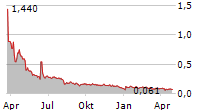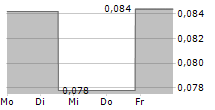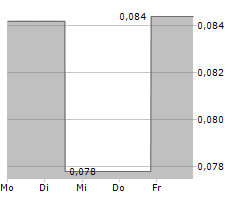
Calgary, Alberta--(Newsfile Corp. - June 27, 2024) - Showcase Minerals Inc. (CSE: SHOW) (FSE: ZJ0) ("Showcase" or the "Company") is pleased to announce drill results from the two completed holes at their Dixie Flats-North Star Gold Project in Elko County, Nevada. The 2024 drill program was conducted in Section 18 of T 31N R 54E Hole DF24-01 and was completed to 373.4 meters at an azimuth of 300and dip of -55. This first hole was designed to test for gold mineralization along a fault parallel and west of the Dark Star Fault northern extension (Figure 1). The fault is normal and down dropped to the east. In addition, gold mineralization at the Webb Formation-Devils Gate Limestone was targeted. Section 18 lies at the intersection between a northwest-oriented Emigrant fault zone or corridor, and a north-northeast fault zone that extends at least to the Dark Star Deposit owned by Orla Mining Ltd. This area was chosen for initial drilling because all the previous drill holes with mineralization on Showcase land occur within section 18, and due to its proximity to the Dark Star Fault Extension. Recent Leapfrog modeling by Rangefront Mining Services highlighted these zones. Figure 1 shows the project area and generalized geology of the Emigrant area. A grade cutoff of 0.20 g/t gold at the Emigrant Mine is shown in red.
The geology of Section 18 and hole DF23-01 is typical of the Rain-Emigrant Subdistrict. Alluvium and volcanic tuff and sediments overlie Mississippian age Melandco Formation sandstone previously named Chainman Formation (Ressel et al. 2015), Webb Formation siltstone and shale, and Devonian age Devils Gate limestone. DF23-01 is in the hanging wall of the hereto named East Spring Fault. In contrast, North Bullion, South Bullion, and Darkstar gold mineralization is hosted in rocks that do not occur in the northern Dixie Flat property but may occur further to the south on the Showcase claims under volcanic cover.
In Section 18, gold intercepts occur in the foot wall of this fault which is a horst block at the Melandco-Devils Gate contact. Previous drilling indicates the Webb Formation is very thin or absent across the top of the horst. Intercepts here are typically less than 15 metres and gold grades are less than 0.30 g/t. Like the Emigrant and Rain deposits, the mineralization occurs as silicified breccia at the top of Devils Gate and base of Webb Formation (Figure 2). Holes DF24-01 and DF-24-02 did encounter silicified breccia at the Webb-Devils gate contact. The depth of this contact in DF24-01 was much greater than anticipated. Historic hole DX-5 drilled approximately 40 meters north of the Showcase property line and 220 meters north-northwest of DF24-01 encountered similar breccia and contained a gold intercept of 22 metres of 0.277 g/t at a similar depth (Figure 2). DF24-01 likely ended near the downdip projection of East Spring Fault but did not penetrate it.
The gold results in DF24-01 are not as thick as DX-5 but indicate that mineralization does continue south along the fault (Figure 2). DF24-02 was drilled 316 meters west-northwest of DF24-01 in the horst block, and the 25.9-metre-thick gold intercept encountered is larger than any hole previously drilled on Showcase ground.
Gold assays are shown in Table 1 with silver (Ag), arsenic (As), barium (Ba), mercury (Hg), antimony (Sb), and thallium (Tl) results that are typical indicator elements in the Emigrant system. Of note are the elevated silver assays as the Emigrant deposit is characteristically elevated in silver. Ressel (et al., 2015) interpreted the silver content as evidence that the Emigrant deposit formed at a shallower depth than classic Carlin deposits and may be transitional to an epthermal system. The silver assays obtained in the Showcase drilling confirm that Section 18 is within the Emigrant hydrothermal system.
| Hole ID | From- m | To-m | Au (g/t) | Ag (g/t) | As (ppm) | Ba(ppm) | Hg (ppm) | Sb (ppm) | Tl (ppm) |
| DF24-01 | 368.8 | 374.9 | 0.219 | 1.93 | 324.8 | 938 | 10.9 | 54.7 | 1.9 |
| - | 379.5 | 385.6 | 0.254 | 3.08 | 344.8 | 345 | 10.5 | 54.1 | 6.98 |
| DF24-02 | 112.8 | 138.7 | 0.252 | 3.82 | 141.4 | 1361 | 3.26 | 36.21 | 1.48 |
Table 1- Assay results
Drilling was conducted with a Schramm T685 reverse circulation drill. Sampling began at the base of the Quaternary alluvium, which occurred at 500 metres in DF24-01 and 240 metres in DF24-02. Samples were retrieved every 1.5 metres (5 feet) from a rotary wet splitter that was adjusted to recover approximately 10 kilograms of material. Quality assurance/quality control blanks, standards, and duplicates were inserted approximately every twenty samples and were delivered daily to the ALS Global preparation facility in Elko, Nevada. Duplicate samples were collected at the drill. Samples were crushed to 70% less than 2 millimetres and riffle split to 250 grams. The split was pulverized to 85% passed 75 microns (PREP-31). Assay methods consisted of a 30 gram fire assay with an AA finish (Au-AA23), and aqua regia ICP (ME-MS41). A total of 230 samples were assayed.
In summary, the Showcase 2024 program tested for Webb-Formation-Devils Gate contact mineralization in the foot wall of the normal East Springs Fault (parallel to the Dark Star Fault extension), and fault-controlled mineralization within the fault and contact mineralization in the hanging wall of the fault. Rain-Emigrant type silicified breccia occurs in both drilled holes, but mineralization in the footwall hole DF24-01 is consistent with mineralization in previous neighboring holes and slightly above the cutoff grade of the Emigrant Deposit. Production grades at the Emigrant Mine averaged 0.62 g/t gold (Ressel et al. 2015). The Company's consulting geologist recommends that any further drilling in Section 18 should focus on thicker and higher-grade intercepts. In Section 18, a previous hole 87-6 containing three metres of 0.310 g/t gold occurs 319 meters west-southwest of D24-02 (Figure 2). The area between these holes is untested, and there is a potential for finding thicker and possibly higher-grade intercepts.
An additional target in Section 18 may exist at depth in the Devonian Oxyoke Canyon Formation. This formation is the deepest known mineralized unit in the South Bullion deposit (Sletten et al. 2022). In the Emigrant area, the Oxyoke Canyon Formation is approximately 355 meters beneath the top of the Devils Gate limestone (Ressel et al. 2015) or 355 to 500 meters beneath the surface.
Outside of Section 18, Section 24 to the southwest is crosscut by the Emigrant Fault on the west, and the East Spring Fault on the east. Figure 3 shows CSAMT target areas from a 2017 survey along with the geology, project area, and faults in Figure 1. Other than gravity and CSAMT, there have been no other surveys conducted in this section. The CSAMT targets are between two major faults and may provide further exploration opportunities.
Qualified Person:
Mr. Steve McMillin, M.Sc., C.P.G. is a qualified person as defined by National Instrument 43-101 and has reviewed and approved the technical information in this news release.
About the Dixie Flats- North Star Gold Project:
The Dixie Flats-North Star Gold Project (the "Property" or "Dixie Flats") is located on the east side of the Piñon Mountains, 21 air-miles south of the City of Elko in northeast Nevada. It is a combination of two claim blocks, the Dixie Flats group of claims and the North Star group of claims. The Property is comprised of a total of 236 total unpatented mineral claims on Federal land administered by the US Bureau of Land Management.
The Property lies on the southern margin of the Carlin Trend, a northwest-trending belt of sediment-hosted gold deposits that makes up the greatest geographic concentration of gold deposits in North America, with reported production of more than 92.5 million ounces of gold since 1961 (Muntean, 2019). The Dixie Flats-North Star Gold Project is underlain by rocks known to host gold mineralization on the Carlin Trend, and surface sampling has shown anomalous gold, silver, arsenic, antimony, and mercury levels in rock, soil, and biogeochemical samples from the Property, which is a characteristic geochemical signature of Carlin-Type gold deposits.
The Dixie Flats - North Star Gold Project is approximately three miles south of Newmont Mining Company's Emigrant Springs Mine, which finished production in 2018, and approximately 4.5 miles southeast of the past producing Rain Mine. Both deposits are hosted in dissolution breccia zones at the contact between the Webb mudstone, the basal unit of the overlying assemblage, and the underlying Devils Gate limestone. Prior exploration on the Dixie Flats -North Star Gold Project has been focused on delineating this contact at depth and discovering possible extensions to the regional structures controlling mineralization at the Rain and Emigrant Mines and their demonstrated extension to the Property. The information on the adjacent projects is taken from publicly available sources and is not necessarily indicative of the mineralization in the Dixie Flats - North Star Gold Project.
Additional information on the Dixie Flats - North Star Gold Project can be found in the National Instrument 43-101 ("NI 43-101") technical report entitled "Technical Report on the Dixie Flats-Northstar Gold Exploration Property", Elko, Nevada, dated September 21, 2022, which has been filed on SEDAR+ at www.sedarplus.ca.
About Showcase Minerals Inc.:
Showcase is a Canadian mineral exploration company with an exclusive option to acquire a 100% interest in Dixie Flats-North Star Gold Project and the Woodruff Gold-Vanadium Project (subject to various net smelter returns royalties ranging from 2.25% to 4.25%), which collectively consist of unpatented 254 lode mining claims covering approximately 1,818 hectares located in Elko County, Nevada.
For further information, please contact:
Kirk Reed, President
Showcase Minerals Inc.
Telephone: 1-800-982-0670
Neither the CSE nor its Market Regulator (as that term is defined in CSE policies) accepts responsibility for the adequacy or accuracy of this news release.
References
Ressel, M.W., Dundas, M., Lujan, R., Essman, J., Shumway, P.J, 2015, Shallow Expressions of Carlin-type Hydrothermal System: An Example from the Emigrant Mine, Carlin Trend, Nevada, Geological Society of Nevada, New Concepts and Discoveries: 2015 Symposium Proceedings, p.409-433.
Sletten, M., Bermudez, B., Ibrado, A.S., Lindholm, M., Dyer, T., Anderson, J., Simmons, J.A., Delong, R., Lutes, K, 2022, Form43-101F1 Technical Report Feasibility Study, Elko County, Nevada, Prepared for Gold Standard Ventures Corporation.

Figure 1: Showcase 2024 project area and Emigrant Mine geology (After Ressel et al., 2015)
To view an enhanced version of this graphic, please visit:
https://images.newsfilecorp.com/files/9723/214690_c6e2a53a84c86b0f_002full.jpg

Figure 2: 2024 Dixie Flats drill locations and results. Dashed red line marks area for possible follow-up exploration.
To view an enhanced version of this graphic, please visit:
https://images.newsfilecorp.com/files/9723/214690_c6e2a53a84c86b0f_003full.jpg

Figure 3: CSAMT targets in Section 24.
To view an enhanced version of this graphic, please visit:
https://images.newsfilecorp.com/files/9723/214690_c6e2a53a84c86b0f_004full.jpg
Not for distribution to United States newswire services or for dissemination in the United States.

To view the source version of this press release, please visit https://www.newsfilecorp.com/release/214690
SOURCE: Showcase Minerals Inc.



